Circles
9.1 Angle Subtended by a Chord at a Point
You have already studied about circles and its parts in Class VI.
Take a line segment $P Q$ and a point $R$ not on the line containing PQ. Join PR and QR (see Fig. 9.1). Then $\angle \mathrm{PRQ}$ is called the angle subtended by the line segment $\mathrm{PQ}$ at the point $\mathrm{R}$. What are angles POQ, PRQ and PSQ called in Fig. 9.2? $\angle$ POQ is the angle subtended by the chord $\mathrm{PQ}$ at the centre $\mathrm{O}, \angle \mathrm{PRQ}$ and $\angle \mathrm{PSQ}$ are respectively the angles subtended by $\mathrm{PQ}$ at points $\mathrm{R}$ and $\mathrm{S}$ on the major and minor arcs $\mathrm{PQ}$.

Fig. 9.1

Fig. 9.2
Let us examine the relationship between the size of the chord and the angle subtended by it at the centre. You may see by drawing different chords of a circle and angles subtended by them at the centre that the longer is the chord, the bigger will be the angle subtended by it at the centre. What will happen if you take two equal chords of a circle? Will the angles subtended at the centre be the same or not?
Draw two or more equal chords of a circle and measure the angles subtended by them at the centre (see Fig.9.3). You will find that the angles subtended by them at the centre are equal. Let us give a proof of this fact.

Fig. 9.3
Theorem 9.1 : Equal chords of a circle subtend equal angles at the centre.
Proof : You are given two equal chords AB and CD of a circle with centre O (see Fig.9.4). You want to

Fig. 9.3

Fig. 9.4
(Corresponding parts of congruent triangles)
Remark : For convenience, the abbreviation CPCT will be used in place of ‘Corresponding parts of congruent triangles’, because we use this very frequently as you will see.
Now if two chords of a circle subtend equal angles at the centre, what can you say about the chords? Are they equal or not? Let us examine this by the following activity:
Take a tracing paper and trace a circle on it. Cut it along the circle to get a disc. At its centre $\mathrm{O}$, draw an angle $\mathrm{AOB}$ where $\mathrm{A}, \mathrm{B}$ are points on the circle. Make another angle $\mathrm{POQ}$ at the centre equal to $\angle A O B$. Cut the disc along $A B$ and $P Q$ (see Fig. 9.5). You will get two segments ACB and PRQ of the circle. If you put one on the other, what do you observe? They cover each other, i.e., they are congruent. $\mathrm{So} \mathrm{AB}=\mathrm{PQ}$.

Fig. 9.5
Though you have seen it for this particular case, try it out for other equal angles too. The chords will all turn out to be equal because of the following theorem:
Theorem 9.2 : If the angles subtended by the chords of a circle at the centre are equal, then the chords are equal.
The above theorem is the converse of the Theorem 9.1. Note that in Fig. 9.4, if you take $\angle \mathrm{AOB}=\angle \mathrm{COD}$, then
$\triangle \mathrm{AOB} \cong \triangle \mathrm{COD}$ (Why?)
Can you now see that $\mathrm{AB}=\mathrm{CD}$ ?
EXERCISE 9.1
1. Recall that two circles are congruent if they have the same radii. Prove that equal chords of congruent circles subtend equal angles at their centres.
Show Answer
Solution
A circle is a collection of points which are equidistant from a fixed point. This fixed point is called as the centre of the circle and this equal distance is called as radius of the
circle. And thus, the shape of a circle depends on its radius. Therefore, it can be observed that if we try to superimpose two circles of equal radius, then both circles will cover each other. Therefore, two circles are congruent if they have equal radius. Consider two congruent circles having centre $O$ and $O^{\prime}$ and two chords $A B$ and $C D$ of equal lengths.

In $\triangle A O B$ and $\triangle C^{\prime} ’ D$,
$A B=C D$ (Chords of same length)
$OA=O^{\prime} C$ (Radii of congruent circles)
$OB=O$ ‘D (Radii of congruent circles)
$\triangle AOB \quad \triangle CO$ ‘D (SSS congruence rule) $\quad \therefore \cong \Rightarrow^{\circ}$
$AOB=\stackrel{\angle}{C} CO^{\prime} D$(By CPCT)
Hence, equal chords of congruent circles subtend equal angles at their centres.
2. Prove that if chords of congruent circles subtend equal angles at their centres, then the chords are equal.
Show Answer
Solution
Let us consider two congruent circles (circles of same radius) with centres as $O$ and $O^{\prime}$.

In $\triangle AOB$ and $\triangle CO^{\prime} D$,
$\angle A O B=\angle C^{\prime}$ D (Given)
$OA=O^{\prime} C$ (Radii of congruent circles)
$OB=O$ ‘D (Radii of congruent circles)
$\therefore \quad \triangle AOB \cong \triangle CO^{\prime} D$ (SSS congruence rule)
$\Rightarrow \quad AB=CD$ (By CPCT)
Hence, if chords of congruent circles subtend equal angles at their centres, then the chords are equal.
9.2 Perpendicular from the Centre to a Chord
Activity : Draw a circle on a tracing paper. Let $\mathrm{O}$ be its centre. Draw a chord AB. Fold the paper along a line through $\mathrm{O}$ so that a portion of the chord falls on the other. Let the crease cut $\mathrm{AB}$ at the point $\mathrm{M}$. Then, $\angle \mathrm{OMA}=\angle \mathrm{OMB}=90^{\circ}$ or $\mathrm{OM}$ is perpendicular to AB. Does the point B coincide with A (see Fig.9.6)?
Yes it will. So MA=MB.

Fig. 9.6
Give a proof yourself by joining $\mathrm{OA}$ and $\mathrm{OB}$ and proving the right triangles OMA and OMB to be congruent. This example is a particular instance of the following result:
Theorem 9.3 : The perpendicular from the centre of a circle to a chord bisects the chord.
What is the converse of this theorem? To write this, first let us be clear what is assumed in Theorem 9.3 and what is proved. Given that the perpendicular from the centre of a circle to a chord is drawn and to prove that it bisects the chord. Thus in the converse, what the hypothesis is ‘if a line from the centre bisects a chord of a circle’ and what is to be proved is ’the line is perpendicular to the chord’. So the converse is:
Theorem 9.4 : The line drawn through the centre of a circle to bisect a chord is perpendicular to the chord.
Is this true? Try it for few cases and see. You will see that it is true for these cases. See if it is true, in general, by doing the following exercise. We will write the stages and you give the reasons.
Let $\mathrm{AB}$ be a chord of a circle with centre $\mathrm{O}$ and $\mathrm{O}$ is joined to the mid-point $\mathrm{M}$ of $\mathrm{AB}$. You have to prove that $\mathrm{OM} \perp \mathrm{AB}$. Join $\mathrm{OA}$ and $\mathrm{OB}$ (see Fig. 9.7). In triangles OAM and OBM,
$$ \begin{aligned} \mathrm{OA} & =\mathrm{OB}\quad \text{(Why ?)}\\ \mathrm{AM} & =\mathrm{BM}\quad \text{(Why ?)} \\ \mathrm{OM} & =\mathrm{OM}\quad \text{(Common)} \end{aligned} $$

Fig. 9.7
Therefore, $\triangle \mathrm{OAM} \cong \triangle \mathrm{OBM}\quad \text{(How ?)}$
This gives $\angle \mathrm{OMA}=\angle \mathrm{OMB}=90^{\circ} \quad$ (Why?)
9.3 Equal Chords and their Distances from the Centre
Let $\mathrm{AB}$ be a line and $\mathrm{P}$ be a point. Since there are infinite numbers of points on a line, if you join these points to $\mathrm{P}$, you will get infinitely many line segments $\mathrm{PL_1}, \mathrm{PL_2}, \mathrm{PM}, \mathrm{PL_3}, \mathrm{PL_4}$, etc. Which of these is the distance of AB from P? You may think a while and get the answer. Out of these line segments, the perpendicular from $\mathrm{P}$ to $\mathrm{AB}$, namely $\mathrm{PM}$ in Fig. 9.8, will be the least. In Mathematics, we define this least length $P M$ to be the distance of $A B$ from $P$. So you may say that:

Fig. 9.8
The length of the perpendicular from a point to a line is the distance of the line from the point.
Note that if the point lies on the line, the distance of the line from the point is zero.
A circle can have infinitely many chords. You may observe by drawing chords of a circle that longer chord is nearer to the centre than the smaller chord. You may observe it by drawing several chords of a circle of different lengths and measuring their distances from the centre. What is the distance of the diameter, which is the longest chord from the centre? Since the centre lies on it, the distance is zero. Do you think that there is some relationship between the length of chords and their distances from the centre? Let us see if this is so.

(i)

(ii)

Fig. 9.9
Activity : Draw a circle of any radius on a tracing paper. Draw two equal chords $\mathrm{AB}$ and $\mathrm{CD}$ of it and also the perpendiculars $\mathrm{OM}$ and $\mathrm{ON}$ on them from the centre O. Fold the figure so that D falls on B and C falls on A [see Fig. 9.9 (i)]. You may observe that $\mathrm{O}$ lies on the crease and $\mathrm{N}$ falls on $\mathrm{M}$. Therefore, $\mathrm{OM}=\mathrm{ON}$. Repeat the activity by drawing congruent circles with centres $\mathrm{O}$ and $\mathrm{O}^{\prime}$ and taking equal chords $A B$ and $C D$ one on each. Draw perpendiculars $O M$ and $O^{\prime} N$ on them [see Fig. 9.9(ii)]. Cut one circular disc and put it on the other so that $A B$ coincides with $\mathrm{CD}$. Then you will find that $\mathrm{O}$ coincides with $\mathrm{O}^{\prime}$ and $\mathrm{M}$ coincides with $\mathrm{N}$. In this way you verified the following:
Theorem 9.5 : Equal chords of a circle (or of congruent circles) are equidistant from the centre (or centres).
Next, it will be seen whether the converse of this theorem is true or not. For this, draw a circle with centre O. From the centre O, draw two line segments OL and OM of equal length and lying inside the circle [see Fig. 9.10(i)]. Then draw chords PQ and RS of the circle perpendicular to OL and OM respectively [see Fig 9.10(ii)]. Measure the lengths of PQ and RS. Are these different? No, both are equal. Repeat the activity for more equal line segments and drawing the chords perpendicular to them. This verifies the converse of the Theorem 9.5 which is stated as follows:

(i)

(ii)
Fig. 9.10
Theorem 9.6 : Chords equidistant from the centre of a circle are equal in length. We now take an example to illustrate the use of the above results:
Example 1 : If two intersecting chords of a circle make equal angles with the diameter passing through their point of intersection, prove that the chords are equal.
Solution : Given that $\mathrm{AB}$ and $\mathrm{CD}$ are two chords of a circle, with centre $\mathrm{O}$ intersecting at a point $\mathrm{E}$. $\mathrm{PQ}$ is a diameter through $\mathrm{E}$, such that $\angle \mathrm{AEQ}=\angle \mathrm{DEQ}$ (see Fig.9.11). You have to prove that $\mathrm{AB}=\mathrm{CD}$. Draw perpendiculars OL and OM on chords $\mathrm{AB}$ and $\mathrm{CD}$, respectively. Now

Fig. 9.11
$$ \begin{aligned} \angle \mathrm{LOE}= & 180^{\circ}-90^{\circ}-\angle \mathrm{LEO}=90^{\circ}-\angle \mathrm{LEO} \\ & \quad(\text { Angle sum property of a triangle }) \\ = & 90^{\circ}-\angle \mathrm{AEQ}=90^{\circ}-\angle \mathrm{DEQ} \\ = & 90^{\circ}-\angle \mathrm{MEO}=\angle \mathrm{MOE} \end{aligned} $$

In triangles OLE and OME,
$$ \begin{aligned} \angle \mathrm{LEO} & =\angle \mathrm{MEO}\quad \quad \text{(Why ?)} \\ \angle \mathrm{LOE} & =\angle \mathrm{MOE}\quad \quad \text{(Proved above)} \\ \mathrm{EO} & =\mathrm{EO}\quad \quad \text{(Common)} \\ \text{Therefore},\quad\Delta \mathrm{OLE} & \cong \Delta \mathrm{OME}\quad \quad \text{(Why ?)} \\ \text{This gives}\quad\mathrm{OL} & =\mathrm{OM}\quad \quad \text{(CPCT)} \\ So,\quad\mathrm{AB} & =\mathrm{CD}\quad \quad \text{(Why?)} \end{aligned} $$
EXERCISE 9.2
1. Two circles of radii $5 \mathrm{~cm}$ and $3 \mathrm{~cm}$ intersect at two points and the distance between their centres is $4 \mathrm{~cm}$. Find the length of the common chord.
Show Answer
Solution
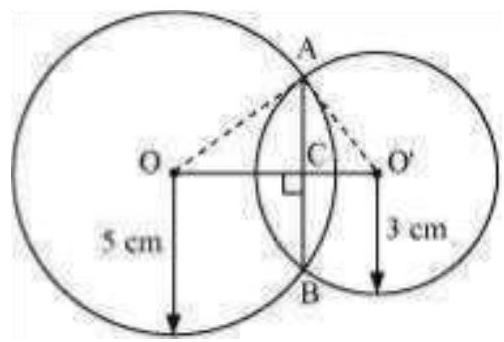
Let the radius of the circle centered at $O$ and $O^{\prime}$ be $5 cm$ and $3 cm$ respectively.
$OA=OB=5 cm$
$O^{\prime} A=O^{\prime} B=3 cm$
$O O$ ’ will be the perpendicular bisector of chord $A B$.
$\therefore A C=C B$
It is given that, $OO^{\prime}=4 cm$
Let $O C$ be $x$. Therefore, $O^{\prime} C$ will be $4-x$.
In $\triangle OAC$,
$OA^{2}=AC^{2}+OC^{2}$
$ \begin{aligned} & \Rightarrow \quad 5^{2}=A C^{2}+x^{2} \\ & \Rightarrow \quad 25-x^{2}=A C^{2} \ldots(1) \text{ In } \end{aligned} $
$\triangle O^{\prime} A C$,
$O^{\prime} A^{2}=A C^{2}+O^{\prime} C^{2}$
$\Rightarrow 3^{2}=A C^{2}+(4-x)^{2}$
$\Rightarrow 9=AC^{2}+16+x^{2}-8 x$
$\Rightarrow \quad AC^{2}=-x^{2}-7+8 x \ldots$
From equations (1) and (2), we obtain
$25-x^{2}=-x^{2}-7+8 x$
$8 x=32 x=4$
Therefore, the common chord will pass through the centre of the smaller circle i.e., O’ and hence, it will be the diameter of the smaller circle.
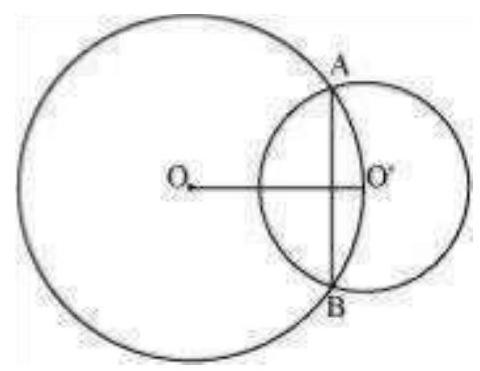
$A C^{2}=25-x^{2}=25-4^{2}=25-16=9$
$\therefore A C=3 m$
Length of the common chord $A B=2 A C=(2 \times 3) m=6 m$
2. If two equal chords of a circle intersect within the circle, prove that the segments of one chord are equal to corresponding segments of the other chord.
Show Answer
Solution
Let $PQ$ and $RS$ be two equal chords of a given circle and they are intersecting each other at point $T$.
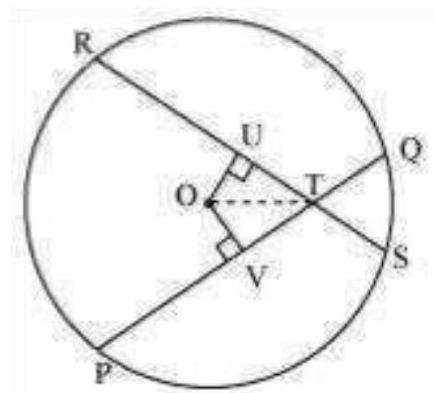
Draw perpendiculars OV and OU on these chords.
In $\triangle OVT$ and $\triangle OUT$,
$OV=OU$ (Equal chords of a circle are equidistant from the centre)
$\angle OVT=\angle OUT(.$ Each $.90^{\circ})$
OT $=$ OT (Common)
$\therefore \Delta OVT \approx \Delta OUT$ (RHS congruence rule) $\therefore VT=$ UT (By CPCT) … (1)
It is given that,
$ \begin{aligned} & PQ=RS \ldots(2) \\ & \frac{1}{2} PQ=\frac{1}{2} RS \\ & \Rightarrow \\ & \Rightarrow PV=RU \ldots(3) \end{aligned} $
On adding equations (1) and (3), we obtain $PV+VT=RU+UT$
$\Rightarrow PT=RT \ldots(4)$
On subtracting equation (4) from equation (2), we obtain
$P Q-P T=R S-R T$
$\Rightarrow QT=ST$
Equations (4) and (5) indicate that the corresponding segments of chords PQ and RS are congruent to each other.
3. If two equal chords of a circle intersect within the circle, prove that the line joining the point of intersection to the centre makes equal angles with the chords.
Show Answer
Solution
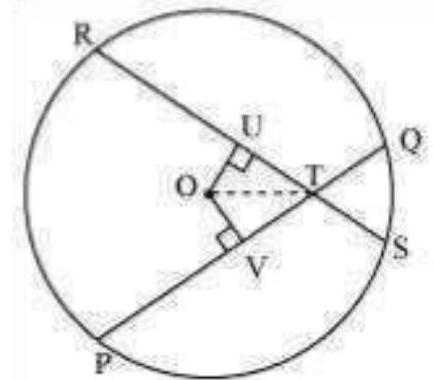
Let $PQ$ and $RS$ are two equal chords of a given circle and they are intersecting each other at point $T$.
Draw perpendiculars OV and OU on these chords.
In $\Delta OVT$ and $\Delta OUT$,
$OV=OU$ (Equal chords of a circle are equidistant from the centre)
$\angle OVT=\angle OUT(.$ Each $90^{\circ}$ )
OT $=$ OT (Common) $\therefore \triangle O V T$ AOUT (RHS congruence rule)
$\therefore$ ÓTV $=$ OfU (By CPCT)
Therefore, it is proved that the line joining the point of intersection to the centre makes equal angles with the chords.
4. If a line intersects two concentric circles (circles with the same centre) with centre $\mathrm{O}$ at $\mathrm{A}, \mathrm{B}, \mathrm{C}$ and $\mathrm{D}$, prove that $\mathrm{AB}=\mathrm{CD}$ (see Fig. 9.12).
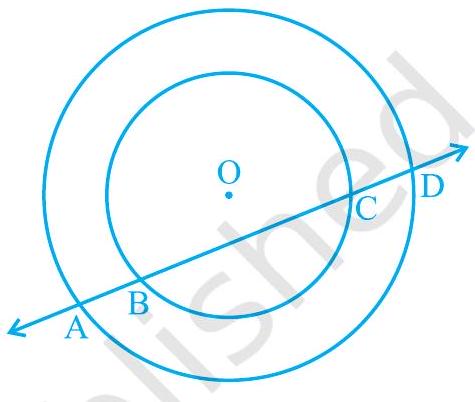
Fig. 9.12
Show Answer
Solution
Let us draw a perpendicular OM on line AD.
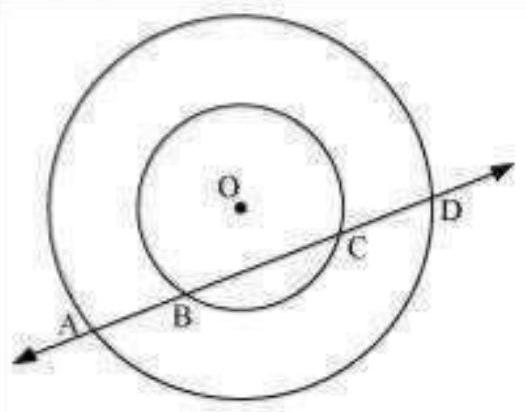
It can be observed that $BC$ is the chord of the smaller circle and $AD$ is the chord of the bigger circle.
We know that perpendicular drawn from the centre of the circle bisects the chord.
$\angle B M=M C \ldots$ (1) And, $A M=M D \ldots$ (2)
On subtracting equation (2) from (1), we obtain
$A M-B M=M D-M C$
$\angle AB=CD$
5. Three girls Reshma, Salma and Mandip are playing a game by standing on a circle of radius $5 \mathrm{~m}$ drawn in a park. Reshma throws a ball to Salma, Salma to Mandip, Mandip to Reshma. If the distance between Reshma and Salma and between Salma and Mandip is $6 \mathrm{~m}$ each, what is the distance between Reshma and Mandip?

Show Answer
Solution
Draw perpendiculars $OA$ and $OB$ on $RS$ and $SM$ respectively.
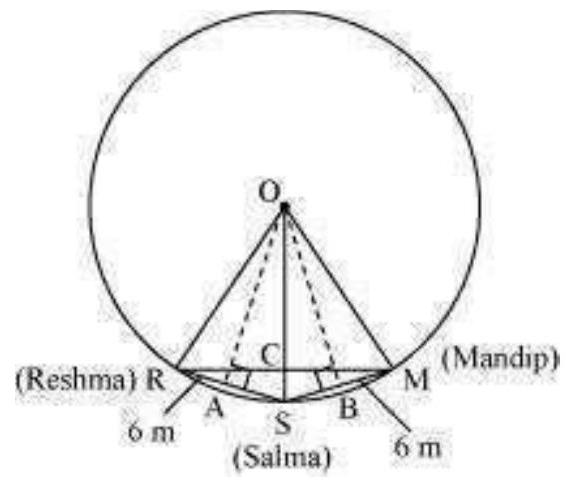
$ AR=AS=\frac{6}{2}=3 m $
$OR=OS=OM=5 m$. (Radii of the circle)
In $\triangle OAR$,
$OA^{2}+AR^{2}=OR^{2}$
$OA^{2}+(3 m)^{2}=(5 m)^{2}$
$OA^{2}=(25-9) m^{2}=16 m^{2}$
$OA=4 m$
ORSM will be a kite ( $O R=O M$ and $R S=S M)$. We know that the diagonals of a kite are perpendicular and the diagonal common to both the isosceles triangles is bisected by another diagonal.
$\angle \angle$
RCS will be of $90^{\circ}$ and $RC=CM$
$\frac{1}{2} \times OA \times RS$
Area of $\triangle ORS=$
$\frac{1}{2} \times RC \times OS=\frac{1}{2} \times 4 \times 6$
$RC \times 5=24$
$RC=4.8$
$RM=2 RC=2(4.8)=9.6$
Therefore, the distance between Reshma and Mandip is $9.6 m$.
6. A circular park of radius $20 \mathrm{~m}$ is situated in a colony. Three boys Ankur, Syed and David are sitting at equal distance on its boundary each having a toy telephone in his hands to talk each other. Find the length of the string of each phone.
Show Answer
Solution
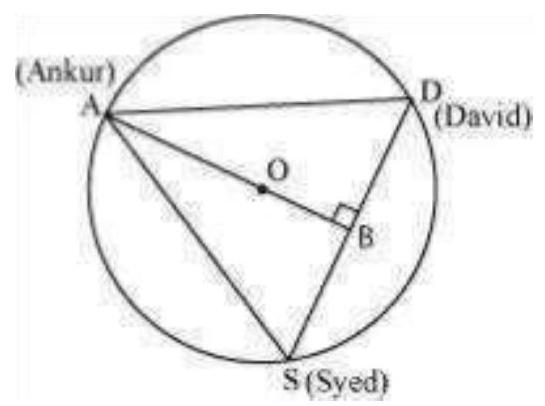
It is given that $A S=S D=D A$
Therefore, $\triangle ASD$ is an equilateral triangle. $OA($ radius) $=20 m$
Medians of equilateral triangle pass through the circum centre $(O)$ of the equilateral triangle ASD. We also know that medians intersect each other in the ratio 2: 1 . As
$A B$ is the median of equilateral triangle $A S D$, we can write
$\Rightarrow \frac{OA}{OB}=\frac{2}{1}$
$\Rightarrow \frac{20 m}{OB}=\frac{2}{1}$
$\Rightarrow OB=(\frac{20}{2}) m=10 m$
$\angle AB=OA+OB=(20+10) m=30 m$
In $\triangle ABD$,
$A D^{2}=A B^{2}+B D^{2}$
$A D^{2}=(30)^{2}+(\frac{A D}{2})^{2}$
$AD^{2}=900+\frac{1}{4} AD^{2}$
$\frac{3}{4} AD^{2}=900$
$AD^{2}=1200$
$AD=20 \sqrt{3}$
Therefore, the length of the string of each phone will be $20 \sqrt{3} m$.
9.4 Angle Subtended by an Arc of a Circle
You have seen that the end points of a chord other than diameter of a circle cuts it into two arcs - one major and other minor. If you take two equal chords, what can you say about the size of arcs? Is one arc made by first chord equal to the corresponding arc made by another chord? In fact, they are more than just equal in length. They are congruent in the sense that if one arc is put on the other, without bending or twisting, one superimposes the other completely.
You can verify this fact by cutting the arc, corresponding to the chord $\mathrm{CD}$ from the circle along $\mathrm{CD}$ and put it on the corresponding arc made by equal chord AB. You will find that the arc CD superimpose the arc AB completely (see Fig. 9.13). This shows that equal chords make congruent arcs and conversely congruent arcs make equal chords of a circle. You can state it as follows:

Fig. 9.13
If two chords of a circle are equal, then their corresponding arcs are congruent and conversely, if two arcs are congruent, then their corresponding chords are equal.
Also the angle subtended by an arc at the centre is defined to be angle subtended by the corresponding chord at the centre in the sense that the minor arc subtends the angle and the major arc subtends the reflex angle. Therefore, in Fig 9.14, the angle subtended by the minor arc $\mathrm{PQ}$ at $\mathrm{O}$ is $\angle \mathrm{POQ}$ and the angle subtended by the major arc $\mathrm{PQ}$ at $\mathrm{O}$ is reflex angle POQ.
In view of the property above and Theorem 9.1, the following result is true:

Fig. 9.14
Congruent arcs (or equal arcs) of a circle subtend equal angles at the centre.
Therefore, the angle subtended by a chord of a circle at its centre is equal to the angle subtended by the corresponding (minor) arc at the centre. The following theorem gives the relationship between the angles subtended by an arc at the centre and at a point on the circle.
Theorem 9.7 : The angle subtended by an arc at the centre is double the angle subtended by it at any point on the remaining part of the circle.
Proof : Given an arc PQ of a circle subtending angles POQ at the centre $\mathrm{O}$ and PAQ at a point $A$ on the remaining part of the circle. We need to prove that $\angle \mathrm{POQ}=2 \angle \mathrm{PAQ}$.

(i)

(ii)

(iii)
Fig. 9.15
Consider the three different cases as given in Fig. 9.15. In (i), arc PQ is minor; in (ii), arc PQ is a semicircle and in (iii), arc PQ is major.
Let us begin by joining $\mathrm{AO}$ and extending it to a point $\mathrm{B}$.
In all the cases,
$$ \angle \mathrm{BOQ}=\angle \mathrm{OAQ}+\angle \mathrm{AQO} $$
because an exterior angle of a triangle is equal to the sum of the two interior opposite angles.
Also in $\triangle \mathrm{OAQ}$,
$\quad \quad \quad \mathrm{OA}=\mathrm{OQ}\quad \text{(Radii of a circle)}$
Therefore, $\quad \angle \mathrm{OAQ}=\angle \mathrm{OQA} \quad \text{(Theorem 7.5)}$
This gives $\quad \angle \mathrm{BOQ}=2 \angle \mathrm{OAQ} \quad (1)$
Similarly, $ \quad \angle \mathrm{BOP}=2 \angle \mathrm{OAP} \quad (2)$
From (1) and (2), $\quad \angle \mathrm{BOP}+\angle \mathrm{BOQ}=2(\angle \mathrm{OAP}+\angle \mathrm{OAQ})$
This is the same as $\quad \angle \mathrm{POQ}=2 \angle \mathrm{PAQ}\quad (3)$
For the case (iii), where $\mathrm{PQ}$ is the major arc, (3) is replaced by
$$ \text { reflex angle } \mathrm{POQ}=2 \angle \mathrm{PAQ} $$
Remark : Suppose we join points $\mathrm{P}$ and $\mathrm{Q}$ and form a chord PQ in the above figures. Then $\angle \mathrm{PAQ}$ is also called the angle formed in the segment PAQP.
In Theorem 9.7, A can be any point on the remaining part of the circle. So if you take any other point $\mathrm{C}$ on the remaining part of the circle (see Fig. 9.16), you have
$\quad \quad \quad \angle \mathrm{POQ}=2 \angle \mathrm{PCQ}=2 \angle \mathrm{PAQ}$
Therefore, $\quad \angle \mathrm{PCQ}=2 \angle \mathrm{PAQ}$.

Fig. 9.16
This proves the following:
Theorem 9.8 : Angles in the same segment of a circle are equal.
Again let us discuss the case (ii) of Theorem 10.8 separately. Here $\angle \mathrm{PAQ}$ is an angle in the segment, which is a semicircle. Also, $\angle \mathrm{PAQ}=\frac{1}{2} \angle \mathrm{POQ}=\frac{1}{2} \times 180^{\circ}=90^{\circ}$. If you take any other point $\mathrm{C}$ on the semicircle, again you get that
$$ \angle \mathrm{PCQ}=90^{\circ} $$
Therefore, you find another property of the circle as:
Angle in a semicircle is a right angle.
The converse of Theorem 9.8 is also true. It can be stated as:
Theorem 9.9 : If a line segment joining two points subtends equal angles at two other points lying on the same side of the line containing the line segment, the four points lie on a circle (i.e. they are concyclic).
You can see the truth of this result as follows:
In Fig. 9.17, $\mathrm{AB}$ is a line segment, which subtends equal angles at two points $\mathrm{C}$ and $\mathrm{D}$. That is

Fig. 9.17
$$ \angle \mathrm{ACB}=\angle \mathrm{ADB} $$
To show that the points $\mathrm{A}, \mathrm{B}, \mathrm{C}$ and $\mathrm{D}$ lie on a circle let us draw a circle through the points A, C and B. Suppose it does not pass through the point $\mathrm{D}$. Then it will intersect $\mathrm{AD}$ (or extended $\mathrm{AD}$ ) at a point, say $\mathrm{E}$ (or $\mathrm{E}^{\prime}$ ).
If points $\mathrm{A}, \mathrm{C}, \mathrm{E}$ and $\mathrm{B}$ lie on a circle,
$$ \angle \mathrm{ACB}=\angle \mathrm{AEB} \quad \text{(Why?)} $$
But it is given that $\quad \angle \mathrm{ACB}=\angle \mathrm{ADB}$.
Therefore, $\quad \quad \angle \mathrm{AEB}=\angle \mathrm{ADB} .$
This is not possible unless $\mathrm{E}$ coincides with $\mathrm{D}$. (Why?)

Similarly, E’ should also coincide with D.
9.5 Cyclic Quadrilaterals
A quadrilateral $\mathrm{ABCD}$ is called cyclic if all the four vertices of it lie on a circle (see Fig 9.18). You will find a peculiar property in such quadrilaterals. Draw several cyclic quadrilaterals of different sides and name each of these as ABCD. (This can be done by drawing several circles of different radii and taking four points on each of them.) Measure the opposite angles and write your observations in the following table.

Fig. 9.18
| S.No. of Quadrilateral | $\angle \mathrm{A}$ | $\angle \mathrm{B}$ | $\angle \mathrm{C}$ | $\angle \mathrm{D}$ | $\angle \mathrm{A}+\angle \mathrm{C}$ | $\angle \mathrm{B}+\angle \mathrm{D}$ |
|---|---|---|---|---|---|---|
| 1. | ||||||
| 2. | ||||||
| 3. | ||||||
| 4. | ||||||
| 5. | ||||||
| 6. |
What do you infer from the table?
You find that $\angle \mathrm{A}+\angle \mathrm{C}=180^{\circ}$ and $\angle \mathrm{B}+\angle \mathrm{D}=180^{\circ}$, neglecting the error in measurements. This verifies the following:
Theorem 9.10 : The sum of either pair of opposite angles of a cyclic quadrilateral is $180^{\circ}$.
In fact, the converse of this theorem, which is stated below is also true.
Theorem 9.11 : If the sum of a pair of opposite angles of a quadrilateral is $180^{\circ}$, the quadrilateral is cyclic.
You can see the truth of this theorem by following a method similar to the method adopted for Theorem 9.9.
Example 2 : In Fig. 9.19, $\mathrm{AB}$ is a diameter of the circle, $\mathrm{CD}$ is a chord equal to the radius of the circle. $\mathrm{AC}$ and $\mathrm{BD}$ when extended intersect at a point $\mathrm{E}$. Prove that $\angle \mathrm{AEB}=60^{\circ}$.

Fig. 9.19
Solution : Join OC, OD and BC.
Triangle ODC is equilateral $\quad$ (Why?)
Therefore, $\angle \mathrm{COD}=60^{\circ}$
Now, $\quad \angle \mathrm{CBD}=\frac{1}{2} \angle \mathrm{COD} \quad$ (Theorem 9.7)
This gives $\quad \angle \mathrm{CBD}=30^{\circ}$
Again, $\quad \angle \mathrm{ACB}=90^{\circ}\quad $(Why ?)
So, $\quad \angle \mathrm{BCE}=180^{\circ}-\angle \mathrm{ACB}=90^{\circ}$
Which gives $\angle \mathrm{CEB}=90^{\circ}-30^{\circ}=60^{\circ}$, i.e., $\angle \mathrm{AEB}=60^{\circ}$

Example 3 : In Fig 9.20, ABCD is a cyclic quadrilateral in which $\mathrm{AC}$ and $\mathrm{BD}$ are its diagonals. If $\angle \mathrm{DBC}=55^{\circ}$ and $\angle \mathrm{BAC}=45^{\circ}$, find $\angle \mathrm{BCD}$.

Fig. 9.20
Solution : $\quad \angle \mathrm{CAD}=\angle \mathrm{DBC}=55^{\circ}$ (Angles in the same segment)
$$ \begin{aligned} \text{Therefore,}\quad \angle \mathrm{DAB} & =\angle \mathrm{CAD}+\angle \mathrm{BAC} \\ & =55^{\circ}+45^{\circ}=100^{\circ} \end{aligned} $$
But $\quad \angle \mathrm{DAB}+\angle \mathrm{BCD}=180^{\circ}$
(Opposite angles of a cyclic quadrilateral)
So,$\quad \angle \mathrm{BCD}=180^{\circ}-100^{\circ}=80^{\circ}$

Example 4 : Two circles intersect at two points A and $\mathrm{B} . \mathrm{AD}$ and $\mathrm{AC}$ are diameters to the two circles (see Fig. 9.21). Prove that B lies on the line segment DC.

Fig. 9.21
Solution : Join AB.
$$ \begin{aligned} & \angle \mathrm{ABD}=90^{\circ} \quad(\text { Angle in a semicircle }) \\ & \angle \mathrm{ABC}=90^{\circ} \quad(\text { Angle in a semicircle }) \end{aligned} $$

So, $\quad \angle \mathrm{ABD}+\angle \mathrm{ABC}=90^{\circ}+90^{\circ}=180^{\circ}$
Therefore, $\mathrm{DBC}$ is a line. That is $\mathrm{B}$ lies on the line segment $\mathrm{DC}$.
Example 5 : Prove that the quadrilateral formed (if possible) by the internal angle bisectors of any quadrilateral is cyclic.
Solution : In Fig. 9.22, ABCD is a quadrilateral in which the angle bisectors $\mathrm{AH}, \mathrm{BF}, \mathrm{CF}$ and $\mathrm{DH}$ of internal angles A, B, C and D respectively form a quadrilateral $\mathrm{EFGH}$.

Fig. 9.22
$$ \begin{aligned} \text{Now,}\quad \angle \mathrm{FEH}=\angle \mathrm{AEB} & =180^{\circ}-\angle \mathrm{EAB}-\angle \mathrm{EBA}(\text { Why } ?) \\ & =180^{\circ}-\frac{1}{2}(\angle \mathrm{A}+\angle \mathrm{B}) \end{aligned} $$

and $\angle \mathrm{FGH}=\angle \mathrm{CGD}=180^{\circ}-\angle \mathrm{GCD}-\angle \mathrm{GDC} \quad$ (Why?)
$$ =180^{\circ}-\frac{1}{2}(\angle \mathrm{C}+\angle \mathrm{D}) $$
Therefore, $\angle \mathrm{FEH}+\angle \mathrm{FGH}=180^{\circ}-\frac{1}{2}(\angle \mathrm{A}+\angle \mathrm{B})+180^{\circ}-\frac{1}{2}(\angle \mathrm{C}+\angle \mathrm{D})$
$$ \begin{aligned} & =360^{\circ}-\frac{1}{2}(\angle \mathrm{A}+\angle \mathrm{B}+\angle \mathrm{C}+\angle \mathrm{D})=360^{\circ}-\frac{1}{2} \times 360^{\circ} \\ & =360^{\circ}-180^{\circ}=180^{\circ} \end{aligned} $$
Therefore, by Theorem 9.11, the quadrilateral EFGH is cyclic.
EXERCISE 9.3
1. In Fig. 9.23, $\mathrm{A}, \mathrm{B}$ and $\mathrm{C}$ are three points on a circle with centre $\mathrm{O}$ such that $\angle \mathrm{BOC}=30^{\circ}$ and $\angle \mathrm{AOB}=60^{\circ}$. If $\mathrm{D}$ is a point on the circle other than the $\operatorname{arc} \mathrm{ABC}$, find $\angle \mathrm{ADC}$.

Fig. 9.23
Show Answer
Solution
It can be observed that
$\angle A O C=\angle A O B+\angle B O C$
$=60^{\circ}+30^{\circ}$
$=90^{\circ}$
We know that angle subtended by an arc at the centre is double the angle subtended by it any point on the remaining part of the circle.
$ \angle ADC=\frac{1}{2} \angle AOC=\frac{1}{2} \times 90^{\circ}=45^{\circ} $
2. A chord of a circle is equal to the radius of the circle. Find the angle subtended by the chord at a point on the minor arc and also at a point on the major arc.
Show Answer
Solution
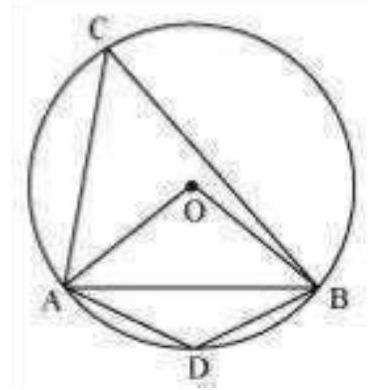
In $\triangle OAB$,
$A B=O A=O B=$ radius
$\angle \triangle OAB$ is an equilateral triangle.
Therefore, each interior angle of this triangle will be of $60^{\circ}$. $\angle \angle AOB=60^{\circ}$
$\angle ACB=\frac{1}{2} \angle AOB=\frac{1}{2}(60^{\circ})=30^{\circ}$
In cyclic quadrilateral $A C B D$,
$\angle ACB+\angle ADB=180^{\circ}$ (Opposite angle in cyclic quadrilateral)
$\angle \angle ADB=180^{\circ}-30^{\circ}=150^{\circ}$
Therefore, angle subtended by this chord at a point on the major arc and the minor arc are $30^{\circ}$ and $150^{\circ}$ respectively.
3. In Fig. 9.24, $\angle \mathrm{PQR}=100^{\circ}$, where $\mathrm{P}, \mathrm{Q}$ and $\mathrm{R}$ are points on a circle with centre $\mathrm{O}$. Find $\angle \mathrm{OPR}$.

Fig. 9.24
Show Answer
Solution
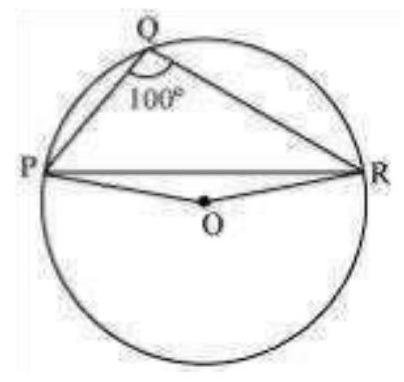
Consider PR as a chord of the circle.
Take any point $S$ on the major arc of the circle.
PQRS is a cyclic quadrilateral.
$\angle PQR+PSR=180^{\circ}$ (Opposite angles of a cyclic quadrilateral)
$\angle P S SR=180^{\circ}-100^{\circ}=80^{\circ}$
We know that the angle subtended by an arc at the centre is double the angle subtended by it at any point on the remaining part of the circle. $\angle \angle POR=2 \angle PSR=$ $2(80^{\circ})=160^{\circ}$
In $\triangle POR$,
$OP=OR$ (Radii of the same circle)
$\angle$ OPPR $=$ ORP (Angles opposite to equal sides of a triangle)

4. In Fig. 9.25, $\angle \mathrm{ABC}=69^{\circ}, \angle \mathrm{ACB}=31^{\circ}$, find $\angle \mathrm{BDC}$.

Fig. 9.25
Show Answer
Solution5. In Fig. 9.26, A, B, C and D are four points on a circle. $\mathrm{AC}$ and $\mathrm{BD}$ intersect at a point $\mathrm{E}$ such that $\angle \mathrm{BEC}=130^{\circ}$ and $\angle \mathrm{ECD}=20^{\circ}$. Find $\angle \mathrm{BAC}$.

Fig. 9.26
Show Answer
Solution
$\angle CDE+DCE=\angle CEB$ (Exterior angle)
$\angle C D E+20^{\circ}=130^{\circ}$
$\angle CDE=110^{\circ}$
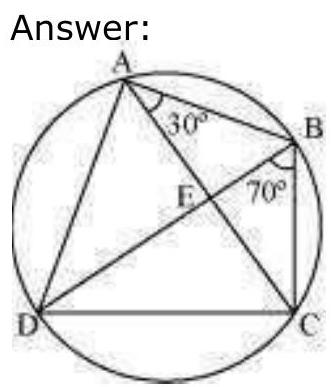
For chord CD,
$<\quad<$
$\angle CAD=70^{\circ}$
$ \begin{aligned} & \angle \quad \angle \quad B C D+B A=180^{\circ} \text{ (Opposite angles of a } By \\ & +100^{\circ}=180^{\circ} \quad BCD \\ & \angle BCD=80^{\circ} \\ & \text{ In } \triangle ABC \text{, } \\ & AB=BC \text{ (Given) } \\ & \angle \angle BCA=\angle CAB \text{ (Angles opposite to equal sides of a triangle) } \\ & \angle \angle BCA=30^{\circ} \end{aligned} $
$ \angle \quad \angle \quad BCD+BAD=180^{\circ} \text{ (Opposite angles of a cyclic quadrilateral) } \angle $
However, $\angle BAC=\angle CDE$ (Angles in the same segment of a circle)
$\angle \angle BAC=110^{\circ}$
6. $\mathrm{ABCD}$ is a cyclic quadrilateral whose diagonals intersect at a point $\mathrm{E}$. If $\angle \mathrm{DBC}=70^{\circ}$, $\angle \mathrm{BAC}$ is $30^{\circ}$, find $\angle \mathrm{BCD}$. Further, if $\mathrm{AB}=\mathrm{BC}$, find $\angle \mathrm{ECD}$.
Show Answer
Solution
$BAD=BAC+CAD=30^{\circ}+70^{\circ}=100^{\circ}$
CD + BAD $=180^{\circ}$ (Opposite angles of a cyclic quadrilateral) $\angle$
We have, $B^{\prime} C D=80^{\circ}$
$ \begin{aligned} & \angle B^{\prime} C A+A C D=80^{\circ} \\ & \circ+A C D=80^{\circ} 30 \quad A C D \\ & \angle=\angle 50^{\circ} \\ & \angle \angle \\ & E C D=50^{\circ} \end{aligned} $
7. If diagonals of a cyclic quadrilateral are diameters of the circle through the vertices of the quadrilateral, prove that it is a rectangle.
Show Answer
Solution
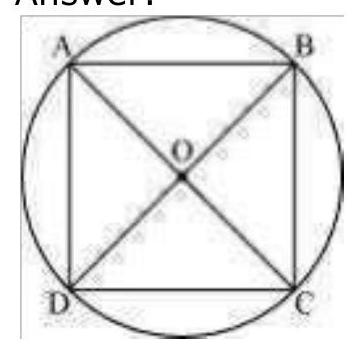
Let $A B C D$ be a cyclic quadrilateral having diagonals $B D$ and $A C$, intersecting each other at point $O$.
$ \angle BAD=\frac{1}{2} \angle BOD=\frac{180^{\circ}}{2}=90^{\circ} $
$ \begin{aligned} & \angle BCD+\angle BAD=180^{\circ} \text{ (Cyclic quadrilateral) (Consider } BD \text{ as a chord) } \\ & \angle BCD=180^{\circ}-90^{\circ}=90^{\circ} \\ & \angle ADC=\frac{1}{2} \angle AOC=\frac{1}{2}(180^{\circ})=90^{\circ} \\ & \angle ADC+\angle ABC=180^{\circ}(\text{ Cyclic quadrilateral })^{\circ} \\ & +\angle ABC=180^{\circ} 90 \end{aligned} $
$\angle A B C=90^{\circ}$
(Considering $AC$ as a chord)
Each interior angle of a cyclic quadrilateral is of $90^{\circ}$. Hence, it is a rectangle.
8. If the non-parallel sides of a trapezium are equal, prove that it is cyclic.
Show Answer
Solution
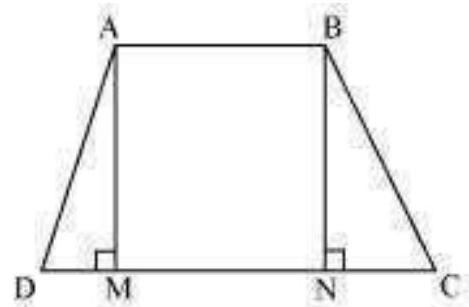
Consider a trapezium $A B C D$ with $A B|| C D$ and $B C=A D$.
Draw $AM \angle CD$ and $BN \angle CD$.
In $\triangle A M D$ and $\triangle B N C$,
$A D=B C$ (Given)
$\angle AMD=\angle BNC(.$ By construction, each is $.90^{\circ})$
$AM=BM$ (Perpendicular distance between two parallel lines is same)
$\angle \triangle AMD \triangle BNC$ (RHS congruence rule)
$\angle A D C=B C \mathscr{C}(C P C T) \ldots$
${ }^{\angle} B A D$ and $A D C$ are on the same side of transversal AD.
$\angle BAD+\stackrel{\angle ADC}{ }=180^{\circ}$.
$\angle \quad \angle$
$B A D+B C D=180^{\circ}[$ Using equation (1)]
This equation shows that the opposite angles are supplementary.
Therefore, $A B C D$ is a cyclic quadrilateral.
9. Two circles intersect at two points B and C. Through B, two line segments ABD and PBQ are drawn to intersect the circles at $\mathrm{A}, \mathrm{D}$ and $\mathrm{P}$, $Q$ respectively (see Fig. 9.27). Prove that $\angle \mathrm{ACP}=\angle \mathrm{QCD}$.

Fig. 9.27
Show Answer
Solution
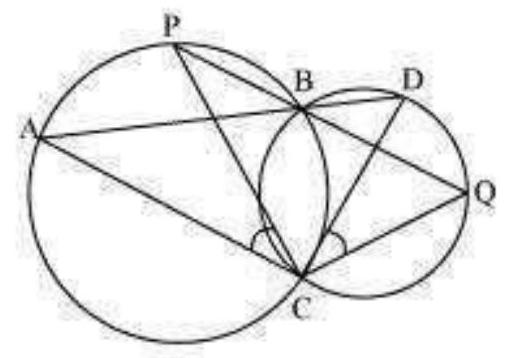
Join chords AP and DQ. $\quad \angle \angle$
For chord AP,
$\angle PBA=\angle ACP$ (Angles in the same segment) …
For chord DQ,
$\angle DBQ=\Phi CD$ (Angles in the same segment) … (2) ABD and
PBQ are line segments intersecting at $B$.
$\angle PBA=$ DBQ (Vertically opposite angles) … (
From equations ( 1 ), ( 2 ), and ( 3 ), we obtain $\angle A C P$
$=\angle QCD$
10. If circles are drawn taking two sides of a triangle as diameters, prove that the point of intersection of these circles lie on the third side.
Show Answer
Solution

Consider a $\triangle ABC$.
Two circles are drawn while taking $A B$ and $A C$ as the diameter.
Let they intersect each other at $D$ and let $D$ not lie on $B C$.
Join AD.
$\angle ADB=90^{\circ}$ (Angle subtended by semi-circle)
$\angle ADC=90^{\circ}$ (Angle subtended by semi-circle)
$\angle$
$ BDC=\angle ADB+\angle ADC=90^{\circ}+90^{\circ}=180^{\circ} $
Therefore, BDC is a straight line and hence, our assumption was wrong.
Thus, Point $D$ lies on third side $B C$ of $\triangle A B C$.
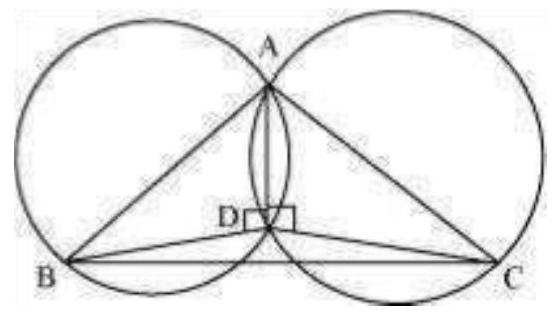
11. $\mathrm{ABC}$ and $\mathrm{ADC}$ are two right triangles with common hypotenuse $\mathrm{AC}$. Prove that $\angle \mathrm{CAD}=\angle \mathrm{CBD}$.
Show Answer
Solution
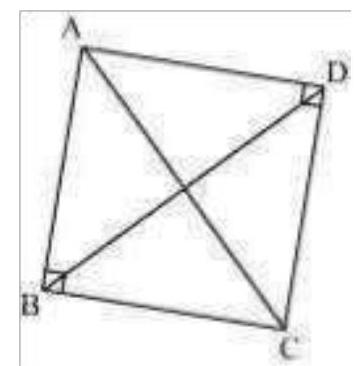
In $\triangle ABC$,
$«<$
$\angle 90^{\circ}+\angle BCA+\angle CAB=180^{\circ}$
$\angle \angle BCA+\angle CAB=90^{\circ} \ldots$ (1) $ABC+BCA+CAB=180^{\circ}$ (Angle sum property of a triangle)
In $\triangle ADC$,
$\angle C D A+A C D+D A C=180^{\circ}$ (Angle sum property of a triangle)
$\angle 90^{\circ}+A^{\prime} C D+D^{\prime} C=180^{\circ}$
${ }^{\angle} A C D+D A C=90^{\circ}$
Adding equations (1) and (2), we obtain
$ BCA+CAB+ACD+DAC=180^{\circ} $
$\angle(BCA+\stackrel{\angle}{\angle} \angle ACD)+(CAB+DAC)=180^{\circ}$
$$ \begin{equation*} BCD+DAB=180^{\circ} \tag{3} \end{equation*} $$
However, it is given that
$\angle B+D=90^{\circ}+90^{\circ}=180^{\circ} \ldots$
From equations (3) and (4), it can be observed that the sum of the measures of opposite angles of quadrilateral $A B C D$ is $180^{\circ}$. Therefore, it is a cyclic quadrilateral.
Consider chord CD.
$\angle CAD=\angle CBD$ (Angles in the same segment)

12. Prove that a cyclic parallelogram is a rectangle.
Show Answer
Solution
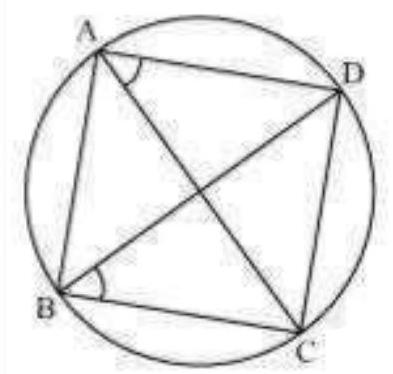
Let $A B C D$ be a cyclic parallelogram. $\angle<$ A $+C=180^{\circ}$ (Opposite angles of a cyclic quadrilateral) … (1)
$\angle A=\angle C$ and $\angle B=\angle D$ We know that opposite angles of a parallelogram are equal. $\angle$
From equation (1), $\angle A+\angle C=180^{\circ}$
$\angle \angle A+\angle A=180^{\circ}$
$\angle 2 \angle A=180^{\circ}$
$\angle \angle A=90^{\circ}$
Parallelogram $ABCD$ has one of its interior angles as $90^{\circ}$. Therefore, it is a rectangle.
9.6 Summary
In this chapter, you have studied the following points:
1. A circle is the collection of all points in a plane, which are equidistant from a fixed point in the plane.
2. Equal chords of a circle (or of congruent circles) subtend equal angles at the centre.
3. If the angles subtended by two chords of a circle (or of congruent circles) at the centre (corresponding centres) are equal, the chords are equal.
4. The perpendicular from the centre of a circle to a chord bisects the chord.
5. The line drawn through the centre of a circle to bisect a chord is perpendicular to the chord.
6. Equal chords of a circle (or of congruent circles) are equidistant from the centre (or corresponding centres).
7. Chords equidistant from the centre (or corresponding centres) of a circle (or of congruent circles) are equal.
8. If two arcs of a circle are congruent, then their corresponding chords are equal and conversely if two chords of a circle are equal, then their corresponding arcs (minor, major) are congruent.
9. Congruent arcs of a circle subtend equal angles at the centre.
10. The angle subtended by an arc at the centre is double the angle subtended by it any point on the remaining part of the circle.
11. Angles in the same segment of a circle are equal.
12. Angle in a semicircle is a right angle.
13. If a line segment joining two points subtends equal angles at two other points lying on the same side of the line containing the line segment, the four points lie on a circle.
14. The sum of either pair of opposite angles of a cyclic quadrilateral is $180^{\circ}$.
15. If sum of a pair of opposite angles of a quadrilateral is $180^{\circ}$, the quadrilateral is cyclic.






